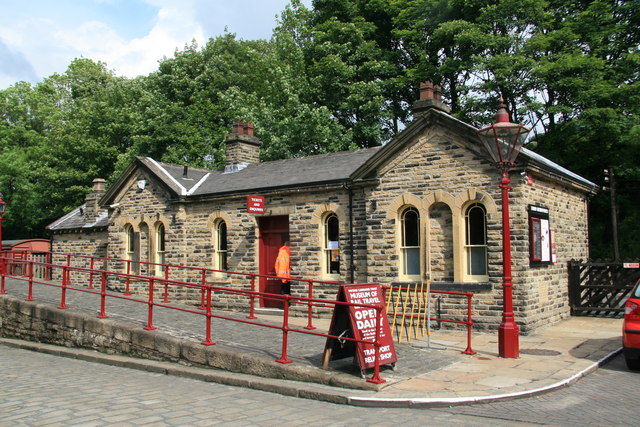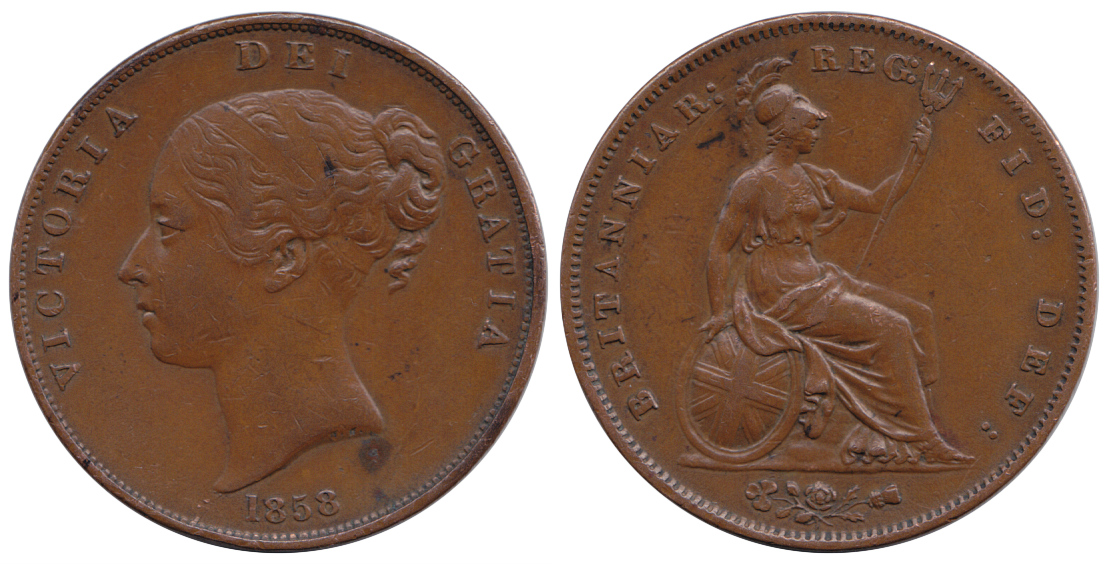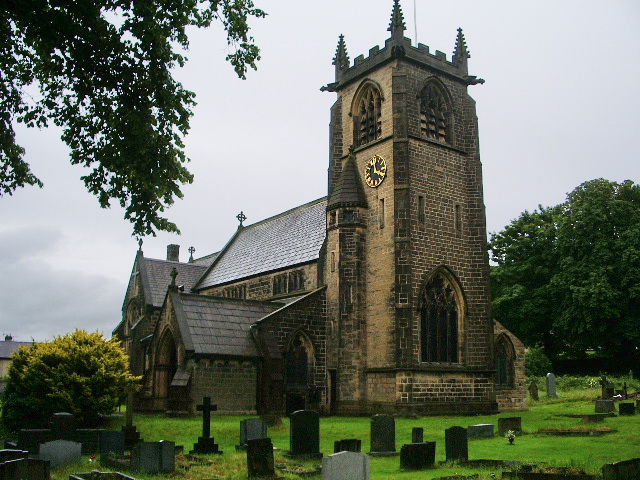|
Keighley Corporation Tramways
Keighley Tramways Company operated a tramway service in Keighley between 1889 and 1901 with horse power. The system re-opened three days later as Keighley Corporation Tramways and stayed in service until 1924 when it closed for good. History Keighley Tramways Company constructed a horse-drawn tramway from Ingrow through Keighley to Utley. Services started on 8 May 1889 and were extended into Stockbridge. The company also plied a route from Coney Lane (where the successor company would build a power station) onto Marley Street via East Parade in the town. All services cost 1d (1 pence) and the interval of services was every 10 minutes stretching to 14 minutes on a Saturday." This service was originally single track, but after electrification, double track was installed. The service was never financially successful. The only dividend ever paid by the company was when it was wound up in 1901. The company sold out to Keighley Corporation and the 30 horses and 6 tramcars and o ... [...More Info...] [...Related Items...] OR: [Wikipedia] [Google] [Baidu] |
Keighley
Keighley ( ) is a market town and a civil parish in the City of Bradford Borough of West Yorkshire, England. It is the second largest settlement in the borough, after Bradford. Keighley is north-west of Bradford city centre, north-west of Bingley, north of Halifax and south-east of Skipton. It is governed by Keighley Town Council and Bradford City Council. Keighley sits between the counties of West Yorkshire, North Yorkshire and Lancashire. Historically in the West Riding of Yorkshire, it lies between Airedale and Keighley Moors. At the 2011 census, Keighley had a population of 56,348. History Toponymy The name Keighley, which has gone through many changes of spelling throughout its history, means "Cyhha's farm or clearing", and was mentioned in the Domesday Book of 1086: "In Cichhelai, Ulchel, and Thole, and Ravensuar, and William had six carucates to be taxed." Town charter Henry de Keighley, a Lancashire knight, was granted a charter to hold a market in Keighley ... [...More Info...] [...Related Items...] OR: [Wikipedia] [Google] [Baidu] |
Ingrow
Ingrow is a suburb of Keighley, West Yorkshire, England that lies on the River Worth. The name Ingrow comes from Old Scandinavian which means 'corner of land in the meadow.' The suburb is located on the A629 road and is south west of Keighley town centre. The Ingrow Railway Centre has two railway museums: the Museum of Rail Travel owned by Vintage Carriages Trust, and Ingrow Loco, owned by the Bahamas Locomotive Society. The museums (off South Street A629) are adjacent to Ingrow (West) railway station, Ingrow Station on the Keighley and Worth Valley Railway, a long heritage railway that serves Keighley, Ingrow, Damems, Oakworth, Haworth and Oxenhope. Between 1884 and 1955 Ingrow had a second railway station (Ingrow (East) railway station, Ingrow East), adjacent to, but higher than the current railway station. This station was on the Great Northern Railway (Great Britain), Great Northern route between Keighley, Halifax railway station (West Yorkshire), Halifax and Bradford Exc ... [...More Info...] [...Related Items...] OR: [Wikipedia] [Google] [Baidu] |
Utley, West Yorkshire
Utley is a village that forms a suburb of the town of Keighley within the county of West Yorkshire, England, approximately from the town centre. History In 1086 the Craven section of the Domesday Book lists ''Utelaia'' as owned by the Viking Vilts. He was taxed on about of arable ploughland here. He also owned Newsholme but shared Oakworth with Gamel Bern. It has been suggested that the name means oat field or outfield (of Keighley) or that it was a meadow (Ley) owned by Utta. Utley was a small collection of buildings when the Keighley to Skipton Turnpike opened up in the early 18th century. The road became the dividing line between Low and High Utley and in the 1930s, the road became the A629 road. The A629 was downgraded into the B6265 when the A629 Kildwick to Beechcliffe bypass was opened in August 1988. In 2001 the area had a population of 5,000 which had risen to 5,500 by the 2011 census. Facilities It has a large secondary school on Greenhead Lane ( Carlton Keighl ... [...More Info...] [...Related Items...] OR: [Wikipedia] [Google] [Baidu] |
Penny (British Pre-decimal Coin)
The British pre-decimal penny was a denomination of sterling coinage worth of one pound or of one shilling. Its symbol was ''d'', from the Roman denarius. It was a continuation of the earlier English penny, and in Scotland it had the same monetary value as one pre-1707 Scottish shilling. The penny was originally minted in silver, but from the late 18th century it was minted in copper, and then after 1860 in bronze. The plural of "penny" is "pence" when referring to an amount of money, and "pennies" when referring to a number of coins. Thus 8''d'' is eight pence, but "eight pennies" means specifically eight individual penny coins. Before Decimal Day in 1971, sterling used the Carolingian monetary system (£sd), under which the largest unit was a pound (£) divisible into 20 shillings (s), each of 12 pence (d). The penny was withdrawn in 1971 due to decimalisation, and replaced (in effect) by the decimal half new penny, with p being worth 1.2''d''. History The kingdoms o ... [...More Info...] [...Related Items...] OR: [Wikipedia] [Google] [Baidu] |
Keighley Corporation Tramways
Keighley Tramways Company operated a tramway service in Keighley between 1889 and 1901 with horse power. The system re-opened three days later as Keighley Corporation Tramways and stayed in service until 1924 when it closed for good. History Keighley Tramways Company constructed a horse-drawn tramway from Ingrow through Keighley to Utley. Services started on 8 May 1889 and were extended into Stockbridge. The company also plied a route from Coney Lane (where the successor company would build a power station) onto Marley Street via East Parade in the town. All services cost 1d (1 pence) and the interval of services was every 10 minutes stretching to 14 minutes on a Saturday." This service was originally single track, but after electrification, double track was installed. The service was never financially successful. The only dividend ever paid by the company was when it was wound up in 1901. The company sold out to Keighley Corporation and the 30 horses and 6 tramcars and o ... [...More Info...] [...Related Items...] OR: [Wikipedia] [Google] [Baidu] |
Sutton-in-Craven
Sutton-in-Craven is a village, electoral ward and (as just Sutton) a civil parish in the Craven district of North Yorkshire, England that is situated in the Aire Valley between Skipton and Keighley. Historically part of the West Riding of Yorkshire, in 2001 the population was 3,480, increasing to 3,714 at the Census 2011. The village is adjacent to Glusburn and Cross Hills, but although these three effectively form a small town, Sutton village maintains its distinct identity. History The village existed before 1086 as "Sutun": listed in the ''Domesday Book''. The landowner then was Ravenkeld who was taxed on 240 acres (100 hectares) of ploughland. But lands were then given by the Norman crown to its compatriots: Robert de Romille followed by Edmund de Boyvill and then Adam de Copley. In the 14th century, the village was known as Sutton-in-Ayrdale but became Sutton-in-Craven in 1620. In the late 17th century Sutton-in-Craven became part of the ancient parish of Kildwick so a ... [...More Info...] [...Related Items...] OR: [Wikipedia] [Google] [Baidu] |
Oakworth
Oakworth is a village in West Yorkshire, England, near Keighley, by the River Worth. The name "Oakworth" indicates that the village was first established in a heavily wooded area. Oakworth railway station is on the route of the Keighley and Worth Valley Railway and was a location in the film ''The Railway Children''. History On folio 301v of the Domesday Book of 1086, Oakworth is called "Acurde" which translated into an Oak clearing. It was taxed on c120 acres (c50 hectares) of arable ploughland shared by the Vikings Vilts and Gamel Bern. Vilts also owned Newsholme and Utley; and Gamel Bern was of the family of noblemen that held the most land in Northern England. However, later, on folio 327r, the Domesday Book states of Oakworth lands that "Gamal Bern had them; Gilbert Tison has them" for in the Harrying of the North all lands were taken from Anglo-Scandinavians and given to Norman Lords. Landmarks Holden Park in Oakworth occupies the grounds of an historic house ow ... [...More Info...] [...Related Items...] OR: [Wikipedia] [Google] [Baidu] |
Austria
Austria, , bar, Östareich officially the Republic of Austria, is a country in the southern part of Central Europe, lying in the Eastern Alps. It is a federation of nine states, one of which is the capital, Vienna, the most populous city and state. A landlocked country, Austria is bordered by Germany to the northwest, the Czech Republic to the north, Slovakia to the northeast, Hungary to the east, Slovenia and Italy to the south, and Switzerland and Liechtenstein to the west. The country occupies an area of and has a population of 9 million. Austria emerged from the remnants of the Eastern and Hungarian March at the end of the first millennium. Originally a margraviate of Bavaria, it developed into a duchy of the Holy Roman Empire in 1156 and was later made an archduchy in 1453. In the 16th century, Vienna began serving as the empire's administrative capital and Austria thus became the heartland of the Habsburg monarchy. After the dissolution of the H ... [...More Info...] [...Related Items...] OR: [Wikipedia] [Google] [Baidu] |
First World War
World War I (28 July 1914 11 November 1918), often abbreviated as WWI, was one of the deadliest global conflicts in history. Belligerents included much of Europe, the Russian Empire, the United States, and the Ottoman Empire, with fighting occurring throughout Europe, the Middle East, Africa, the Pacific, and parts of Asia. An estimated 9 million soldiers were killed in combat, plus another 23 million wounded, while 5 million civilians died as a result of military action, hunger, and disease. Millions more died in genocides within the Ottoman Empire and in the 1918 influenza pandemic, which was exacerbated by the movement of combatants during the war. Prior to 1914, the European great powers were divided between the Triple Entente (comprising France, Russia, and Britain) and the Triple Alliance (containing Germany, Austria-Hungary, and Italy). Tensions in the Balkans came to a head on 28 June 1914, following the assassination of Archduke Franz Ferdina ... [...More Info...] [...Related Items...] OR: [Wikipedia] [Google] [Baidu] |
Tram Transport In England
A tram (called a streetcar or trolley in North America) is a rail vehicle that travels on tramway tracks on public urban streets; some include segments on segregated right-of-way. The tramlines or networks operated as public transport are called tramways or simply trams/streetcars. Many recently built tramways use the contemporary term light rail. The vehicles are called streetcars or trolleys (not to be confused with trolleybus) in North America and trams or tramcars elsewhere. The first two terms are often used interchangeably in the United States, with ''trolley'' being the preferred term in the eastern US and ''streetcar'' in the western US. ''Streetcar'' or ''tramway'' are preferred in Canada. In parts of the United States, internally powered buses made to resemble a streetcar are often referred to as "trolleys". To avoid further confusion with trolley buses, the American Public Transportation Association (APTA) refers to them as "trolley-replica buses". In the United ... [...More Info...] [...Related Items...] OR: [Wikipedia] [Google] [Baidu] |
4 Ft Gauge Railways In England
4 (four) is a number, numeral and digit. It is the natural number following 3 and preceding 5. It is the smallest semiprime and composite number, and is considered unlucky in many East Asian cultures. In mathematics Four is the smallest composite number, its proper divisors being and . Four is the sum and product of two with itself: 2 + 2 = 4 = 2 x 2, the only number b such that a + a = b = a x a, which also makes four the smallest squared prime number p^. In Knuth's up-arrow notation, , and so forth, for any number of up arrows. By consequence, four is the only square one more than a prime number, specifically three. The sum of the first four prime numbers two + three + five + seven is the only sum of four consecutive prime numbers that yields an odd prime number, seventeen, which is the fourth super-prime. Four lies between the first proper pair of twin primes, three and five, which are the first two Fermat primes, like seventeen, which is the third. On the other hand, t ... [...More Info...] [...Related Items...] OR: [Wikipedia] [Google] [Baidu] |
.jpg)




